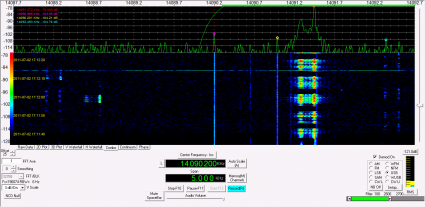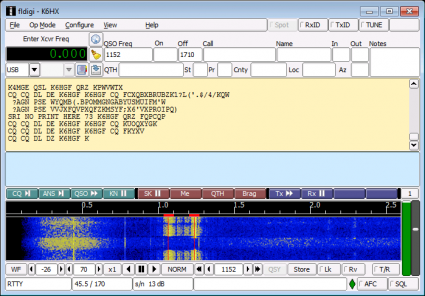I recall burning three or four weeks of a sabbatical getting Saccade.com on the air with Wordpress. So much tweaking…
The sights and sounds of RTTY
Over at the tymkrs blog, they’ve been learning a bit about RTTY as a digital mode, but I found their description a bit theoretical. I’d describe radio teletype (RTTY) as a popular digital mode, particularly among contesters. It encodes text as a stream of five bit code words using a system known as Baudot, and then sends these codes as two tones using frequency shift keying. On the amateur frequencies, these tones are typically 170 Hz apart, and sent at 45.45 baud.
Is that too esoteric for you? Well, here’s some sights and sounds.
First of all, here’s the sound. I recorded the following minute of audio using my SDR-IQ this morning around 14.090 Mhz, on the 20m band. There is apparently some contest going on, as I observed people exchanging sequence numbers and signal reports. I’ve left this uncompressed, so in theory, if you have any software that can decode RTTY, you can play it back and see what it says (I use fldigi).
RTTY on 20m, recorded on July 2, 2011 (WAV)
If you are using a radio which has a “waterfall” display like are common for software defined radio, you might expect to see the following: RTTY looks like two discrete tones, separated by around 170 Hz. This is the view using my SDR-IQ running Spectravue.
Spectravue doesn’t have an RTTY decoder built in, but fldigi does. If you configure it to use the stereo mixer output of your PC as input, you can use both programs together to decode the RTTY. Here’s what fldigi looks like:
You can see that fldigi has some problems with putting out garbage letters, mostly at the end of transmissions. The squelch control that it has is slow to stop the decoder, and often at the end of a transmission you’ll see a bunch of garbage characters. I’ve wondered how to tune fldigi to minimize that effect, but I haven’t figured it out yet (I’m not much of an RTTYer).
While RTTY has a long history in amateur communications (refer to (refer to Wikipedia for details) it is hardly ever done with vintage equipment anymore, with software replacing vintage teletype terminals. I see it mostly used during contesting, and hardly ever for long “rag chewing” contacts. In recent years, digital modes like PSK31 and Olivia seem to be increasing in popularity at RTTY’s expense: even W1AW has begun to shift their bulletins to PSK31.
If you are a ham, you probably know all this already: this is mostly to help inform the short wave listener or prospective ham. If you are an avid RTTYer, feel free to post your views on the mode as a comment: as I said, I’m no expert, but we’d all love to hear from anyone who is.


Pingback from brainwagon » The sights and sounds of RTTY | Ham Radio Blog
Time 8/17/2011 at 1:45 am
[…] “There is much pleasure in useless knowledge.” — Bertrand Russell. See original here: brainwagon » The sights and sounds of RTTY This entry was posted in Uncategorized and tagged much-pleasure by admin. Bookmark the […]